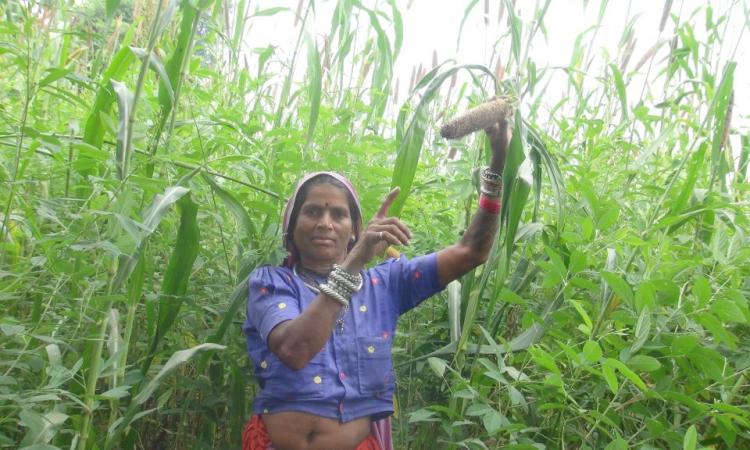
Roughly 85 percent of the farm households in India are small or marginal farmers, that is, they have less than 2 hectares of land, with 70 percent having less than 1 hectare of land. The average landholding is only 0.5 hectares per household (NSO, 2021).
How are these households getting by?
The Mahila Jagat Lihaaz Samiti, an organisation of Bhil Adivasi farmers in Dewas district of Madhya Pradesh, conducted a survey to determine this among 50 Adivasi marginal farmers spread over the districts of Dewas, Indore and Alirajpur in Madhya Pradesh, asking them about their performance in the 2020-21 agricultural year over the two seasons of Kharif and Rabi.
In addition to the farming details, the respondents were also asked about their monthly food consumption. The results of this survey are disturbing, to say the least, and are given in the table below.
Table: Results of Farm and Consumption Expenditure Survey 2020-21
|
Average Daily Per Capita Calories Consumed (Calories) |
Average Daily Per Capita Food Cons. Exp. (Rs) |
Average Daily Per Capita Total Cons. Exp. (Assuming it is double of Food Exp.) (Rs) |
Average Daily Per Capita Farm Income (Dividing Total Net Farm Income by 365 days) (Rs) |
Average Household Labour Wage (Dividing Total Net Farm Income by No. of days of Household Labour) (Rs) |
Average Agricultural Income Per Acre (Rs) |
Average Annual Per Capita days of farm Work (Days) |
|
2092 |
43 |
87 |
14 |
72 |
11950 |
54 |
The average daily per capita food consumption expenditure is Rs 43 whereas the average daily per capita farm income if we were to divide the total net income by 365 days is only Rs 14. Which means that the farm income is grossly inadequate to even cover the food consumption expenditure.
If we assume the total consumption expenditure for such a poor household to be double the food consumption expenditure then the farm income is able to cover only 16 percent of total household expenditure and 32 percent of food expenditure.
No wonder then that the average daily per capita calorie consumption of the sample is only 2092 which is well below the benchmark of 2400 calories for good nutrition as determined by the World Health Organisation.
This has to be compared with the poverty line determined by the World Bank which is $1.9 per capita per day which works out to Rs 42 per day in India in purchasing power parity terms (World Bank, 2021). As is evident from the results above, this poverty line income is not sufficient to even provide a minimum necessary food intake of 2400 calories per day let alone take care of other household expenditures.
Therefore, the determination of the poverty line income is itself faulty and it needs to be at least trebled to ensure that people get adequate nutrition and other benefits. If that is done, then the proportion of people below the poverty line will increase substantially from the 28 per cent that is officially quoted.
One more disconcerting aspect is that these farmers are getting on an average only 54 days of work per capita annually from their farms. Whereas, accounting for holidays they should be getting at least 250 days of work on par with salaried workers in permanent jobs.
Moreover, last year the minimum wage in agriculture was Rs 220 per day but as we can see, the farmers on average got only Rs 72 per day for the number of days they worked. If the farmers are to get Rs 220 per day for 250 days then the income per acre has to increase to a huge Rs 1,65,000 assuming three workers per household, from the paltry Rs 11,950 they are getting now due to depressed prices for their products and the high prices of inputs like seeds, fertilisers and pesticides.
Since this is not forthcoming all the surveyed farmers are also doing wage labour either locally or by migrating to cities like Indore and Surat to make ends meet. The NSO survey cited above also confirms this as it finds that farm production contributes only 37 percent of the total income of farm households and wage labour is more at 40 percent. Obviously, the proportion of farm income is even less for marginal farmer households.
The NSO survey also reveals that this economic unviability has resulted in escalated indebtedness of farming households with 50 percent being in debt with the average outstanding being Rs 74,000.
Despite farm incomes and the employment generated being so low for such a vast majority of farming households there is no largescale data on this as surveys conducted by the NSO do not ask the respondents about the household labour they do on the farms.
Clearly, there is a dire need to reorient agriculture and rural development so as to address this serious problem since industrial development cannot address this huge shortfall. In fact, the pressure created by migration from rural areas into cities has led to a depressing of wages in urban areas and an increase in unemployment there.
The subsidies being provided currently to chemical agriculture which is about 16 percent of the farm GDP and the investment being made through MGNREGS which is another 10 percent of the farm GDP have to be increased substantially. These have to be redirected towards organic agriculture and ecosystem restoration, renewable energy and local post-harvest processing so as to put farming on an ecologically sustainable and economically viable foundation so as to revive smallholder agriculture.
References
NSO (2021): Situation Assessment Survey of Farmers NSS 77th Round (January-December, 2019), National Statistical Organisation, Government of India, New Delhi, 2021.
World Bank (2021): Poverty Indicators, https://www.worldbank.org/en/topic/poverty accessed on 4.10.2021